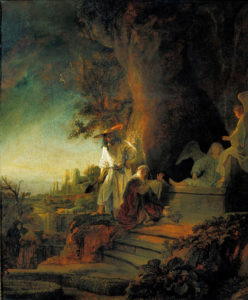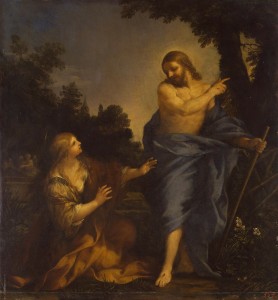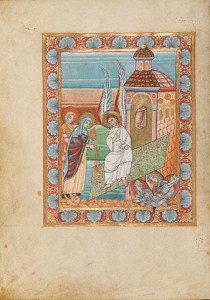Thoughts on Sunday’s Lessons for April 21, 2019
First Reading: Acts 10:34-43
Alleluia! Christ is risen! The Lord is risen indeed, Alleluia! On Easter Sunday, we remember and celebrate the resurrection of Jesus Christ. All of the readings for the principal Easter service remind us of resurrection and life.

The Risen Christ Appearing to Mary Magdalene (1638). Oil painting on panel by Rembrandt Harmenszoon van Rijn (1606-1669). Buckingham Palace collection. (Click image to enlarge.)
These verses from the Acts of the Apostles, the evangelist Luke’s account of the life of the early church, may be used as either the first or second reading. In this passage we see Peter teaching in the household of the centurion Cornelius, a Roman army officer. Peter tells this gentile family about the Christian way: Jesus was crucified, but then raised from the dead, and now God’s saving grace is given through Jesus to all the nations, Jew and Gentile alike. Jesus is Lord of all!
Alternate First Reading: Isaiah 65:17-25
In the closing pages of Isaiah’s great book of prophecy, the people have returned home to Jerusalem from their long exile in Babylon. Much work remains to be done to restore the demolished city and its temple, but this is a time for celebration. God promises through the prophet to make Jerusalem a virtual heaven on earth, where everyone will enjoy abundance and happiness, peace and joy; even the wolf and the lamb shall feed peacefully together! As Christians celebrate the resurrection of Jesus on Easter Sunday, we too imagine a new kingdom where all will be physically and spiritually fed.
Psalm: Psalm 118:1-2, 14-24
Christians have long imagined the “stone the builders rejected” in this Psalm as an image of Jesus, but this song of victory goes deeper still: It exults in God’s never-ending love that saves us and promises everlasting life. Note well, however, that to enter the kingdom of heaven, we are expected to be righteous, and that means practicing justice in our lives, not only for our neighbor but the poor and the stranger, too. Having done this, then we may rejoice, singing, “This is the day that the Lord has made; let us rejoice and be glad in it.”
Second Reading: I Corinthians 15:19-26
In his pastoral words to the early Christians of Corinth, Paul tried to explain what Christ’s resurrection means to us, the people of the church. Recalling Adam’s fall and the ancient covenantal commandment to offer the first fruits of the harvest to God, Paul declares that as all died with Adam, all are made alive again in Christ, the first fruits of our salvation. Christ’s sacrifice and resurrection changes everything for all, as the resurrection promises the arrival of God’s kingdom on earth and of eternal life.
Gospel: John 20:1-18
All four Gospels tell of Christ’s resurrection, of course, but each presents a different viewpoint, offering us a textured, multi-dimensional account when we consider them all. Here in John’s narrative we follow Mary Magdalene, recognizing her in these tender verses as the only one who stayed behind at the empty tomb after the others had left. John portrays her as the first person to meet and speak with the risen Christ, and the one sent to proclaim the good news of his resurrection to the others. As in many other Gospel accounts of the risen Christ encountering his friends in unexpected ways, Mary did not recognize Jesus at first. But when he calls her name, you can feel the joy in her delighted response, “Rabbouni!”
Alternate Gospel: Luke 24:1-12
Eyewitness accounts of any great account often differ on the details, and the Gospels’ resurrection narratives are certainly no exception. Only Luke, for example, tells us that the women who had come with Jesus from Galilee were the first to learn that Jesus was risen; and he even tells us the names of three of them: Mary Magdalene, Joanna, and Mary the mother of James. When they ran back to tell the men this wonderful news, though, the men thought they were only telling “an idle tale,” until Peter ran to the empty tomb to see for himself.


